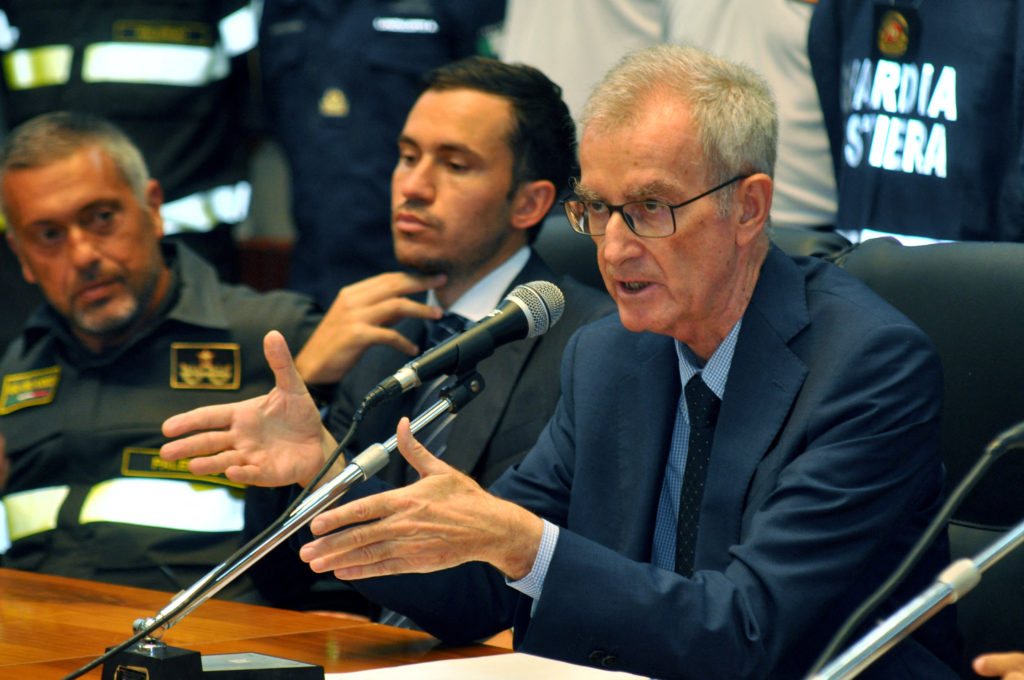Seven people drowned when the superyacht Bayesian sank — including Dr Mike Lynch and his daughter Hannah
 INVESTIGATIONS CONTINUE Chief Prosecutor Ambrogio Cartosio (right) giving a press conference (Photo by Alessandro Fucarini/AFP via Getty Images)
INVESTIGATIONS CONTINUE Chief Prosecutor Ambrogio Cartosio (right) giving a press conference (Photo by Alessandro Fucarini/AFP via Getty Images)INVESTIGATIONS into the sinking of the Bayesian moored off the Sicilian fishing village of Porticello continue this week
All but seven of the 22 people on board the Bayesian - 12 passengers and 10 crew - had scrambled into a life raft as the yacht capsized. The victims included London-Irishman Dr Mike Lynch and his daughter Hannah.
One of the survivors, a crew member, was from Sligo — Sasha Murray (29) from Maugherow.
The owner of the British-registered yacht has been named as Dr Lynch’s wife, Angela Bacares, one of the survivors of the sinking.
Why and how the super yacht sank so quickly while other smaller vessels nearby survived the storm is being pored over by investigators this week. It is now believed that a downburst was the weather phenomenon that hit the ship: a localised, powerful wind that descends from a thunderstorm with intense force. It is possible that it hit the Bayesian with more force than other craft in the area. This is something the investigators will want to find out.
The investigation is being led by Chief Prosecutor Ambrogio Cartosio, head of the prosecutor's office in the nearby town of Termini Imerese. This week his office confirmed that charges of manslaughter, and causing a shipwreck could be considered. Causing a shipwreck is a separate offence under Italian maritime law and those found guilty of provoking or causing a shipwreck could face up to 12 years in prison.
However so far Mr Cartosio has stressed that his investigations are still in their initial stages and not concentrated on anyone specifically. But naturally the captain of the Bayesian, 51-year-old James Catfield from New Zealand, is a focus of the enquiries.
Captain Catfield has already been interviewed at length by Italian authorities. “We didn’t see it coming,” he told Italian media, speaking about the storm. But the Italian investigators will be trying to find out why other boats in the area were aware of impending storms and took precautionary steps. Violent winds and rain were forecast, following days of searing heat which saw the Mediterranean become 3 C warmer than normal.
The investigation team are likely to focus on several elements of the disaster:
(1) Why was the keel not fully lowered? The keel, even in small sailing dinghies is a crucial part of keeping a boat stable. It appears, according to Italian media reports, that the keel on the Bayesian was only partially lowered. Marine experts told the Italian newspaper La Repubblica that gusts of 100 kilometres an hour (62mph) would have been sufficient to capsize the ship if the keel wasn’t filly deployed – and the storm that sank the Bayesian far exceeded that.
(2) Why did the boat not right itself, once it had capsized? This type of boat is designed to do exactly that, even if the keel is not fully deployed. One plausible explanation seems to be that hatches, or side entrances were left open. Water entering would have made the boat unstable, and so unable to right itself.
(3) Was the anchor lifted? Normal practice in severe weather would be to lift the anchor, start the engines, and face the wind in order to ride out severe weather.
(4) When disaster appeared to be inevitable, were the passengers warned by the crew? In any passenger-carrying craft, or ship with a substantially sized crew, protocols should be in place to muster all souls together, provide life jackets and have emergency procedures in place.
As well as taking evidence from the divers who retrieved the bodies, coastguard officials have visited all of the homes and public places with surveillance cameras pointed out to sea in the area, according to Italian news website Palermo Today.
DR MIKE LYNCH and a co-defendant were acquitted in June in a San Francisco court of 15 counts of fraud.
Several of those on board were involved in his recent trial, as the voyage was to celebrate Dr Lynch’s acquittal. The bodies of Clifford Chance lawyer Chris Morvillo and his wife Neda Morvillo were also recovered from the wreckage, along with Jonathan Bloomer, a Morgan Stanley International bank chairman and his wife Judy Bloomer.Dr Lynch’s daughter Hannah also perished in the disaster.
The body of Canadian-Antiguan national Recaldo Thomas, who was working as a chef on the superyacht, was recovered earlier.
In a separate incident, Dr Lynch’s co-defendant in the trial was killed in a road collision in Cambridge last week. Stephen Chamberlain was similarly found innocent in his US fraud trial in which both men were acquitted following the $11bn (£8.64bn) sale of the software company Autonomy to Hewlett Packard.
Mr Chamberlain died after being hit by a car while out running in Cambridgeshire, according to his lawyer.
Dr Mike Lynch was born to Irish parents from humble backgrounds, something that was impressed on the jury. The Lynchs moved from Carrick-on-Suir in Tipperary to Essex, where the young Mike was brought up. His mother was a nurse from Tipperary, his father a fireman from Co. Cork. His Irish heritage, and the fact that his parents were “poor Irish immigrants” to Britain has been alluded to in the trial.
During his testimony Dr Lynch addressed the jury, speaking about growing up during the Troubles in 1970s London as the son of Irish immigrants — “You had to learn to run fast,” he said — and of his first job as a cleaner at the hospital where his mother worked as a nurse. “I’m still a demon mopper,” he said.

